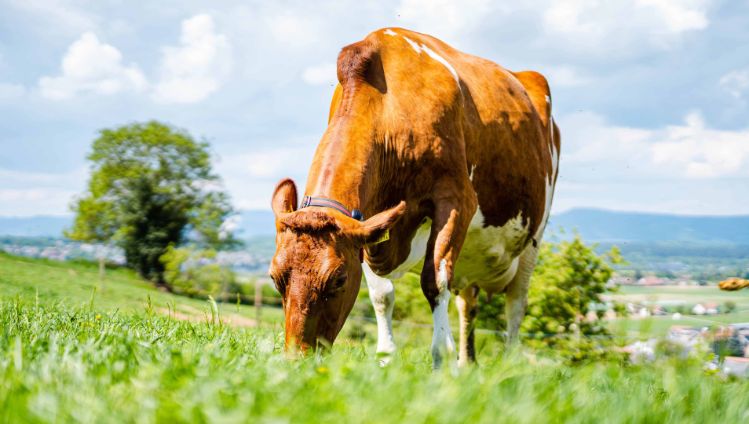
Prevention is better than cure
Animal welfare is difficult to measure. Health is undoubtedly a crucial factor. It was with this in mind that we launched the “healthy and long-living” cows project in 2017. which saw a veterinarian provide regular and preventive support to interested dairy farmers over a period of three years to help them keep their cows fit and healthy. After the project was completed, it was found that the cows’ improved health had a positive effect on fertility. For farmers, this means – among other things – lower costs. The majority of dairy farmers therefore want to continue to make use of herd management. This will likely soon be supported by the new agricultural policy AP22+, which provides for an “Animal Health” incentive programme and welcomes preventive measures for the welfare of livestock.
We are committed to sustainable dairy products. This is why we support our milk suppliers on their way to even more sustainable milk. For example, by working with them to identify innovative solutions.
We regard healthy and long-living dairy cows as a central tenet of sustainable milk production. Not only for animal welfare, but also for ecological and economic reasons. For that reason, in 2017 we went in search of dairy farmers who have the health of their cows checked by a veterinarian on a regular basis and are open to preventive measures.
We were able to count on Beat Berchtold as our partner, who specialises in the fields of herd medicine and ruminant medicine.
For six years now, he has been in charge of “veterinary herd management” – a veterinary practice that focuses on the integrated herd management of dairy herds. The aim of this supervision was to improve the health of the herds and, in turn, the profitability of the farms. The basis for this was established by regular visits to the herd, a relationship of trust between the farm operations manager and the supervising person, a holistic approach to the farm or herd and respect for the individuality of the farms. Every farm is unique and thus has its own operating strategy and philosophy. Accordingly, each farm required an individual strategy in terms of support and implementing measures. Alongside checking and examining fertility, most of the visit was taken up by monitoring udder health and analysing and discussing what and how the dairy cows were fed. On the topic of udder health, in the event of health problems, not only was the milk performance data assessed and evaluated, but also the milking process itself (milking routine, vacuum measurements, investigations into leakage current, etc.). It was important to make connections between the individual areas and, for example, to use feeding to demonstrate a deterioration not only in fertility but also in udder health, so that these results could then be harnessed to develop preventive measures.
In addition, areas of focus were established based on the management needs of the individual farms, such as calf and young animal rearing.
For the project, the farms were visited an average of 24 times a year, with visits lasting 35 minutes on average. Together with the farm operations managers, first of all the status quo was determined (= where we are) and then the goals defined for the years ahead (= where we want to be). These were evaluated at regular intervals and served as the basis each year for a written report – the annual analysis.
Low participation
Although we paid a significant portion of the costs involved in the project, only a few of our milk suppliers took part. Since we were convinced of the benefits of professional herd management, the project was carried out nevertheless. Given the low number of participants, however – just five farms in total – the representative nature of the results is lower than hoped.
Nonetheless, over the project term of three years a clear improvement in health was evident from the improved fertility rate. In this way, the farm operations manager can save a good 50 francs per cow per year. Added to this is a 5 % to 11 % increase in the volume of milk, although this was not an objective of the farmers involved in the project. An increased focus on feeding emerged as an important factor. In addition, it was possible to reduce the use of antibiotics on the farms overall. All of this leads to a high level of satisfaction among farmers, as a result of which the majority of the participating farm operations managers plan to continue to use professional herd management in future. One of the milk producers involved: “We will continue to make use of herd management on our farm. It enables us to make ongoing improvements to performance and animal health. Otherwise, we as farmers run the risk of becoming blind to our business over the years.” In addition to qualified professional management, it is important that farms that make use of veterinary herd management are always supervised by the same person and that visits are carried out on a regular basis in terms of the day of the week and visiting hours.
Experts convinced of the benefits
Professional herd management as a contribution to the welfare of livestock is not yet very widespread in Switzerland. However, its effectiveness among experts is undisputed. This is evident from the Federal Council’s Message on Agricultural Policy 22+ (p. 109). This proposes, for example, that an “Animal Health” incentive programme is introduced to encourage the participation of farms in comprehensive, chiefly preventive programmes such as herd management. We at Emmi very much welcome this project, which will contribute to the further development of sustainability throughout the whole Swiss dairy industry.


